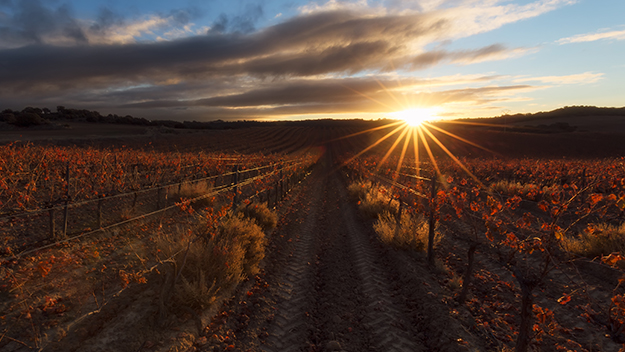Find your winery or vineyard
Infographic of the Denomination of Origin

Change to imperial units (ft2, ac, °F)Change to international units (m2, h, °C)
Sardinia
HISTORY
The island of Sardinia with its capital in Cagliari is the second largest island in the Mediterranean after Sicily. Geologically it is the oldest part of Italy and was once connected to the mainland. It is divided into four provinces: Sassari in the northwest, Oristano in the west, Cagliari in the south and Nuoro in the east.
More than 3,000 years ago, prehistoric Sardinians dragged huge stones to their places of residence, worked them with primitive tools and piled them on top of each other to make the famous Bronze Age stone towers found on the island. These ‘Nuraghi’ are the emblem of Sardinia and also gave their name to the native grape variety Nuragus. As early as the 9th century B.C., the Sardinians practised BC, the Sardinians were practising viticulture, having learned this art from the Phoenicians.
Aristotle tells how the Carthaginians destroyed all the vines in Sardinia for commercial reasons. The first act of resurrection of the vineyard dates back to the 10th century, and is linked to monks. In 1297 James II of Aragon was installed as king of the island with the approval of Pope Boniface VIII, who gave him the right to be king of Sardinia, in order to settle the dispute between the Angevin and Aragonese dynasties for the throne of Sicily.
Under the influence of the Carthaginians, Romans, Vandals, Byzantines, Muslims, Spaniards, Pisans and Genoese, a varied wine-growing spectrum originated. The Spaniards in particular brought many varieties from Spain from the 13th century onwards. In the past, high alcohol wines and sweet liqueur and fortified dessert wines similar to sherry and port were produced. Even today they constitute an important production.
During the Aragonese rule, wine-growing activity was constant:
The Statute of Sassari (1316) allowed citizens to trade wine on the island. The Agrarian Codex of Mariano IV (1346-1376). The Logu charter of Eleanora d'Arborea (1392). The owners were obliged to enclose their vineyards and to facilitate their custody, as well as to win for vine cultivation all the lands where no other vineyard had been planted. To eliminate from all those areas where vineyards could not be cultivated for quality.
The Aragonese domination was responsible, among other things, for the introduction of various innovations in agricultural technology, such as the vine training systems and goblet pruning, which are still in use today. Under Spanish rule, Sardinia gained new markets for wine, such as Flanders and England. The Spanish, by the Treaty of London in 1718 and the Treaty of The Hague in 1720, left Sardinia to the Savoy in exchange for Sicily. From the 18th century onwards, it was the Piedmontese who were responsible for the development of agriculture on the island of Sardinia and the trade in its wines.
TYPES OF GRAPES
The most important white wine varieties are Chardonnay, Malvasia di Sardegna (Malvasia di Lipari), Moscato Bianco (Muscat Blanc), Nasco, Nuragus, Nuragus Arrubiu, Nuragus Moscadeddu, Sauvignon Blanc, Semidano, Torbato, Trebbiano Romagnolo, Trebbiano Toscano and Vermentino.
The main red wine varieties are Bovale Grande or Bovale di Spagna or Carignan, Bovale Sardo or Cagnulari (Graciano), Cabernet Franc, Cabernet Sauvignon, Cannonau (Garnacha tinta), Carcajolo nero (Parraleta), Carmenère, Girò, Merlot, Monica, Niedda Mannu (Pascale) and Sangiovese.
Between the 13th and 18th centuries, the grape varieties introduced into Sardinia from the Iberian Peninsula were:
Cannonau: Red Grenache, which nowadays represents 20% of the Sardinian vineyards and produces the most important wines of the island. It is present in the appellation Cannonau di Sardegna and produces red, young and matured wines, dry liqueur wines and natural sweet liqueur wines. The granite soils, the Mistral wind and the climate of the island give unique Cannonau wines, its original and historical lands are Ogliastra and Barbagia.
Carignano: Carignan, represents 10% of Sardinia's vineyards. It is found in the denomination Carignano del Sulcis and produces red, rosé or passito wines (raisined, in the plant and then in the cellar). It is also called Spanish grape.
Bovale: also called bovale sarda, bovale di Spagna, bovale grande, muristellu (monastrell), nièddera, nieddu mandroni (‘lazy black’) as a sign of contempt, it is nowadays an international oenological star. It is registered in the appellation Campo di Terralba, the wines produced are aged reds. The bovale is usually a complementary variety in many wines. It is the Manchego-Levantine bobal. But it is curious that it is sometimes confused with Monastrell.
Monica: we do not really know its identity, we only know that it was introduced at the time we are referring to. It exists in two denominations of origin as a main variety: Monica di Cagliari, where sweet and dry wines, natural sweet liqueur wines and dry liqueur wines are produced (the latter two with a minimum of nine months in wood) and Monica di Sardegna, red and sparkling wines. It occupies 10% of the Sardinian vineyard.
Girò: it is known to have landed in Sardinia in 1500. It is found in the Giró di Cagliari appellation, the wines produced are natural sweet and dry and liqueur wines aged for a minimum of 9 months for the crianza wine and 2 years for the reserve wine.
Torbato: introduced in 1500 in the Alghero area. Its origin and Spanish equivalence, if any, is unknown. It produces dry white wines.
Vernaccia di Oristano: one of the different types of Vernaccia, not related to each other. It arrived in Sardinia in the 14th century and is responsible for fortified wines influenced by sherry. It is found in the wines under the denomination Vernaccia di Oristano (to be ‘superiore’ it has to be aged for three years and four if it is ‘riserva’; it needs two years if it is sweet or dry liqueur).
There is an appellation called Mandrosilai in the westernmost area which is a compendium of the Sardinian bovale, cannonau and monica grape varieties. The wines are aged reds and rosés.
The grape varieties that came from the Iberian Peninsula are therefore responsible for most of the quality red wines produced in Sardinia today; of course without forgetting the local white grape varieties, such as Vermentino (80 percent of the Italian land cultivated with Vermentino is in Sardinia), Nasco, or others with great identification such as the Sardinian Malvasia, the Malvasia di Bosa in the basaltic soils of the Planargia wine-growing region.
WINES AND WINERIES
The vineyards, especially in the plains, are still cultivated in the traditional Albarello (Gobelet) style. Production is largely dominated by a few large winegrowers' cooperatives (Cantina Sociale). The largest wine marketing company is Sella & Mosca.
The main wineries making wines from these grape varieties are Bodegas Argiolas, surely the best on the island, with wines mainly from Cannonau, with a small addition of carignano and other grape varieties, also making wines with more than 50% bovale sardo and the Monica de Sardegna with 90% Casta Monica, Cantina Sociale Santadi, with centenary carignano vines, Bodega Capichera, with single varietal carignano, Atilio Contini is the most representative producer of Vernaccia di Oristano, Bodega Meloni, with wines of casta girò.
D.O./Valle (wine regions)
Discover more wineries and vineyards for sale in these wine regions in Islands
Subscribe to our mailing list to receive news about wineries and vineyards.







